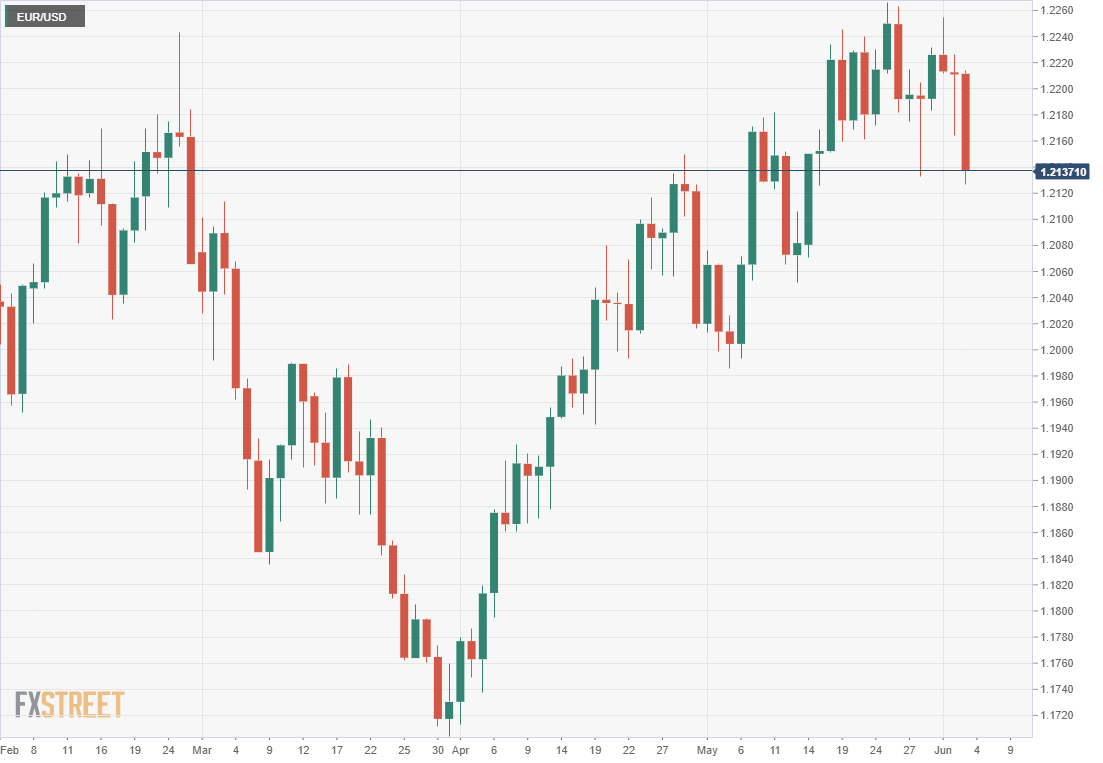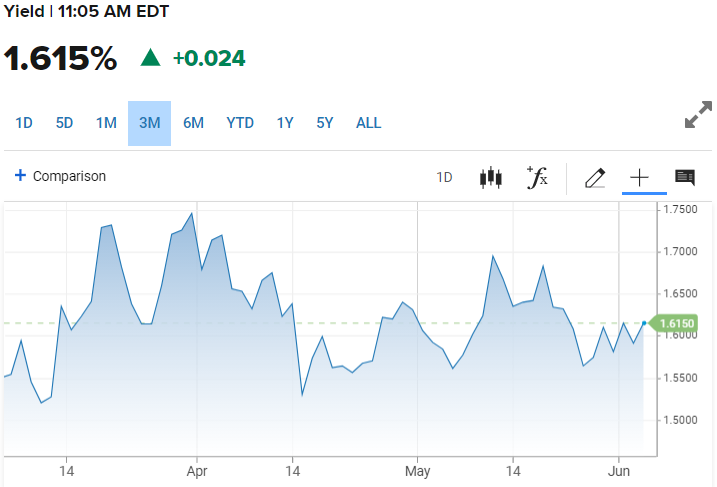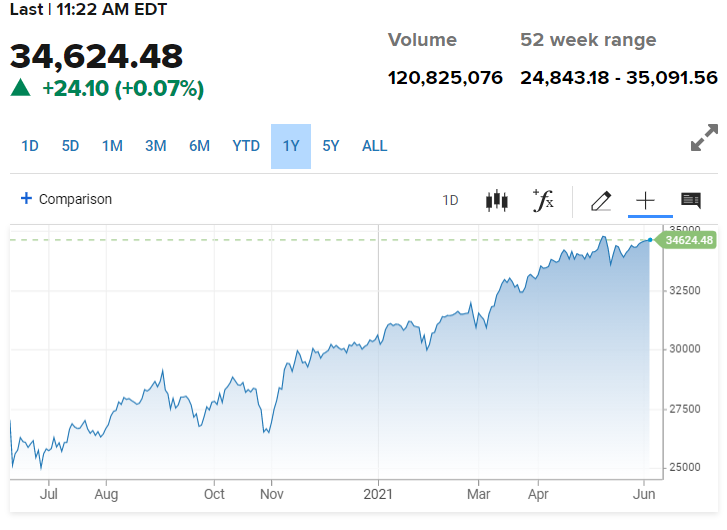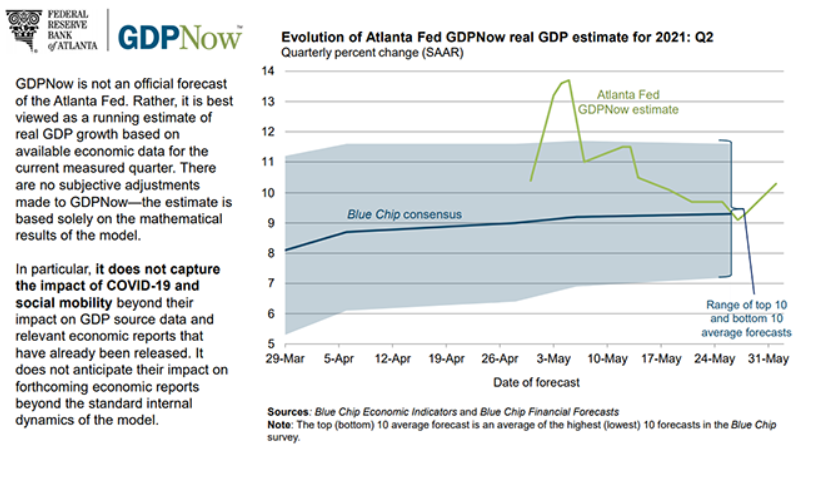- May Nonfarm Payrolls expected to rebound to 664,000.
- Unemployment rate forecast to drop to 5.9% from 6.1%.
- Manufacturing Employment PMI drops to 50.9 in May.
- Markets wary of a repeat of the April NFP debacle.
April’s Nonfarm Payrolls had descended on a market primed for breakout in US statistics.
After 916,000 new hires in March, 41% more than forecast, and 379,000 in February, double estimates, markets were confidently expecting another excellent report with the May 7 release from the Bureau of Labor Statistics (BLS).
The consensus estimate of 978,00 was thought to be ripe for over-fulfilment. With the economy roaring at 11% annualized growth in the second quarter, according to the contemporary Atlanta Fed estimate, speculation over a blowout was rife.
If the whisper numbers of one million new jobs, or even one-and-a-half million had been reached it would have been far less of a shock than the actual drip of 266,000 new hires.
Nonfarm Payrolls
FXStreet
Markets are far more circumspect this time around. Nonfarm Payrolls are forecast to rise 664,000 and the Unemployment rate (U-3) is expected to drop to 5.9% from 6.1%. Average Hourly Earnings are predicted to rise 0.2% after the 0.7% gain in April and to fall 0.4% on the year following the 0.3% increase prior, both reverses attributable to the anticipated hiring of lower wage workers. Average Weekly Hours should fall 0.1 to 34.9. The Labor Force Participation Rate was 61.7% in April and the Underemployment Rate (U-6) was 10.4%.
April economic background
Employment indicators had seemed secure and expansive leading into the April Employment Situation Report, the official name for payrolls.
Initial Jobless Claims had dipped to 498,000 in the April 30 week, the first time below 500,000 for the pandemic.
Clients of the private payroll company, Automatic Data Processing (ADP) reported 742,000 new employees in March, just under the 800,000 forecast and the highest number of new employees since September.
Purchasing Managers’ Indexes (PMI) in manufacturing and services remained strong.
The overall manufacturing PMI dropped to 60.7 from 64.7, missing its 65 forecast, but given the exceptional performance this year and the absolute level that was not indicative of a slowdown.
The New Orders Index dropped to 64.3 in April from 68, here also the recent numbers were remarkably active.
The one possible caveat was the Manufacturing Employment Index which faded to 55.1 from 59.6, well under its 61.5 forecast. As with the others, this was ignored as a minor variation on a very good theme.
Services PMIs delivered the same reassuring notes. The general index fell one point to 62.7, New Orders slid to 63.2 from 67.2 and employment rose to 58.8 in April from 57.2.
Services Employment PMI
April Nonfarm Payrolls
What happened to April payrolls? No one is quite sure.
One possibility is that the BLS seasonal adjustment was far off the mark.The unadjusted Nonfarm Payrolls number was 1.089 million. A seasonal adjustment designed to smooth out recurring monthly swings reduced it to the issued figure of 266,000. These revisions are based on the historical record.
Do assumptions founded in normal seasonal hiring patterns have any predictive value for a time frame as unusual as the past 15 months?
In a normal year summer temporary hiring that might begin in April and May would be discounted as part of long-term employment. This year, a good portion of the more than one million jobs reported in the raw numbers were likely not temporary employment at all but a return to pandemic squelched work. Did the BLS models differentiate between the two putting the rebound in permanent employment in the correct category? Even if the problem was recognized, as it probably was, how can statisticians determine the percentages until the temporary employment ends in the fall?
A second possibility is that the enhanced and extended, from June to September, federal unemployment benefits delayed the return of hundreds of thousands of workers to employment. For lower wage workers whose salaries might not be very different from their jobless benefits, taking the rest of the summer off is hardly an irrational choice.
Market response to April payrolls
The market response to April’s unexpectedly weak payrolls was equivocal. The dollar lost ground initially but in the month since the result has been mixed.
The greenback is lower against the euro, the sterling, the Swiss franc and the Canadian dollar, higher versus the Japanese yen and the Australian and New Zealand dollars.
Treasury rates are little changed. The 10-year Treasury yield opened on May 7 at 1.576%, as of this writing it is 1.615%.The 2-year began trading on May 7 at 0.157%, it is currently at 0.155%.
10-year Treasury yield
CNBC
Equities have pursued the same cautious program. The S&P 500 opened on May 7 at 4,210.34. It is currently trading at 4.200.95. The Dow was at 34,578.27 that morning, it is 34,624.48 presently.
Dow
CNBC
May economic background
Most US statistics continued to improve last month with the important exceptions of employment indexes from the Institute for Supply Management.
The US economy is growing at a 10.3% annual rate in the latest Atlanta Fed estimate.
Initial Jobless Claims have shed more than 100,000 a week, registering 385,000 in the May 28 period.
Private payrolls from ADP had an excellent month adding 978,000, 50% more than the 650,000 forecast, though the April total was revised down to 654,000 from 742,000.
However, the manufacturing sector, as it did in April, is displaying another labor market warning. The ISM Employment PMI dropped sharply to 50.9 in May from 55.1 in April. It had been forecast to rise to 61.5, the same level that was missed in April. The other indexes improved. Overall PMI to 61.2 from 60.7 and New Orders to 67 from 64.3.
The service sector continued to soar. Overall PMI jumped to 64 from 62.7, a more than decade high. New Orders climbed to 63.9 from 63.2, far more optimistic than the 57.9 consensus estimate. Only Employment PMI showed hesitation, dropping to 55.3 from 58.8, missing the 58 prediction. Managers in both sectors noted material shortages and difficulty in finding qualified personnel.
Atlanta Fed GDPNow
Conclusion
Another large miss for US payrolls will be devastating for the recovery narrative. How much of a warning is the weak manufacturing employment PMI? Is the anemic hiring in April and perhaps May a temporary phenomenon related to extended unemployment benefits or is it a sign of deeper problems in the US labor market?
With 8.1 million unfilled positions in the March Job Openings and Labor Turnover Survey (JOLTS), likely more in April and May, and employers offering higher wages, the lack of hiring appears inexplicable.
Fed policy will be the immediate focal point, with the Treasury market the scene of the action. Weak payrolls will help to stave off the inevtiable taper discussion and keep rates stable. Strong job creation will bring the taper, if not a tanturm, to the forefront of Fed policy. Either way it is not a topic the Fed can avoid for much longer.
If the May payroll number disappoints, it will not matter to the markets whether it is from a lack of interested workers or a lack of jobs, the dollar, equities and Treasury yields should fall.
If May payrolls resume rapid growth, even if April remains unexplained, the recovery narrative will restart; but after the recent scare, markets will need additional reassurance before taking that growth to the bank.
Information on these pages contains forward-looking statements that involve risks and uncertainties. Markets and instruments profiled on this page are for informational purposes only and should not in any way come across as a recommendation to buy or sell in these assets. You should do your own thorough research before making any investment decisions. FXStreet does not in any way guarantee that this information is free from mistakes, errors, or material misstatements. It also does not guarantee that this information is of a timely nature. Investing in Open Markets involves a great deal of risk, including the loss of all or a portion of your investment, as well as emotional distress. All risks, losses and costs associated with investing, including total loss of principal, are your responsibility. The views and opinions expressed in this article are those of the authors and do not necessarily reflect the official policy or position of FXStreet nor its advertisers. The author will not be held responsible for information that is found at the end of links posted on this page.
If not otherwise explicitly mentioned in the body of the article, at the time of writing, the author has no position in any stock mentioned in this article and no business relationship with any company mentioned. The author has not received compensation for writing this article, other than from FXStreet.
FXStreet and the author do not provide personalized recommendations. The author makes no representations as to the accuracy, completeness, or suitability of this information. FXStreet and the author will not be liable for any errors, omissions or any losses, injuries or damages arising from this information and its display or use. Errors and omissions excepted.
The author and FXStreet are not registered investment advisors and nothing in this article is intended to be investment advice.
Recommended Content
Editors’ Picks

EUR/USD recovers toward 1.0600 as US Dollar retreats ahead of data
EUR/USD extends the rebound toward 1.0600 in the European session on Friday. The renewed upside is mainly linked to a broad US Dollar pullback as traders look to the topt-tier US Retail Sales data for a fresh impetus. ECB- and Fedspeak also eyed.

GBP/USD holds above 1.2650 after UK data
GBP/USD holds its recovery momentum above 1.2650 in European trading on Friday. The mixed UK GDP and industrial data fail to deter Pound Sterling buyers as the US Dollar rally takes a breather ahead of Retail Sales and Fedspeak.

Gold treads water above $2,545 support, US data eyed
Gold price is treading water above the $2,545 demand area on Friday, consolidating Thursday's late rebound. Fed Chair Powell's hawkish shift fuels rate cut uncertainty, capping the metal's upside. Meanwhile, traders cash in on the US Dollar long positions ahead of key data releases.

Bitcoin to 100k or pullback to 78k?
Bitcoin and Ethereum showed a modest recovery on Friday following Thursday's downturn, yet momentum indicators suggest continuing the decline as signs of bull exhaustion emerge. Ripple is approaching a key resistance level, with a potential rejection likely leading to a decline ahead.

Trump vs CPI
US CPI for October was exactly in line with expectations. The headline rate of CPI rose to 2.6% YoY from 2.4% YoY in September. The core rate remained steady at 3.3%. The detail of the report shows that the shelter index rose by 0.4% on the month, which accounted for 50% of the increase in all items on a monthly basis.

Best Forex Brokers with Low Spreads
VERIFIED Low spreads are crucial for reducing trading costs. Explore top Forex brokers offering competitive spreads and high leverage. Compare options for EUR/USD, GBP/USD, USD/JPY, and Gold.



%20june%203-637583297100317502.png)


